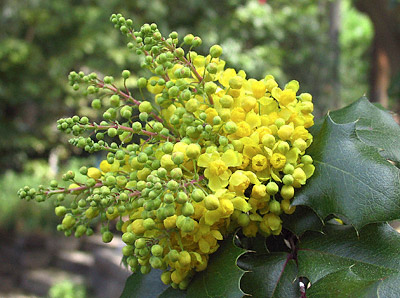
Mahonias – also known as barberries – are wonderful two-season plants: in the spring they have dense clusters of yellow flowers; by the end of summer these turn into lovely blue-purple berries which are prized by birds. The plants themselves are evergreen, forming stiff shrubs that are handsome year-round.
The selection ‘Golden Abundance’ is a cross between several species (including the Oregon Grape, Mahonia aquifolium), and is known for its particularly showy flowers. This hybrid has also proven to be remarkably adaptable: the specimen pictured here is in a sunny position in clay soil and receives only occasional summer water; another we have is in peaty soil in heavy shade at the foot of a eucalyptus, receiving regular garden water (which the eucalyptus promptly sponges up). Both have grown to over 4' in 4 years from one gallon pots and will eventually reach 5–8'; the one with more sun has far more flowers and berries.
There are at least three other Mahonias worth looking into: Mahonia repens (Creeping Mahonia), which is a low spreading shrub that does well in partial shade and some water; Mahonia nevinii (Nevin's Barberry), a rare and endangered plant that loves sun and which forms a dense tangle up to 12' in size with colorful translucent red berries, and Mahonia pinnata (California Grape) that also does well in heat, sun, and drought but forms a smaller (4–10'), neater shrub than M. nevinii. Mahonia ‘Golden Abundance’ and M. repens have larger, smoother leaves that turn red with age; M. nevinii and pinnata have smaller, bluer, prickly leaves that are bronze when new. These also make great barrier plants, as well as thickets for birds to hide in.
Below is an example of our Mahonia ‘Golden Abundance’ starting to flower in spring. You can see where it gets its name! These blooms are particularly well framed by its attractive green leaves, and are regularly visited by insects – even the occasional hummingbird.
